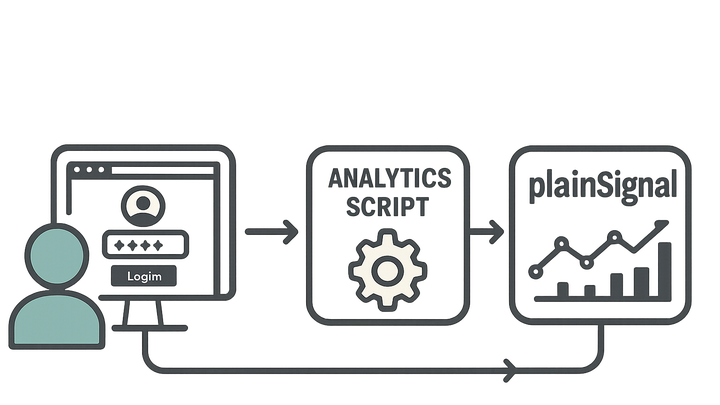Published on 2025-06-22T01:57:25Z
What Is an Authentication Event? Examples for Analytics Platforms
An authentication event in web analytics is a tracked action that signifies a user has successfully logged in, logged out, or otherwise verified their identity within an application or website. These events enable analysts to correlate anonymous browsing data with a known user profile, providing a clearer picture of user behavior, engagement, and retention. Authentication events are critical for understanding conversion funnels, multi-device usage, and long-term customer journeys. They also play a key role in security monitoring by revealing unusual login patterns or potential breaches. Modern analytics platforms like plainSignal and Google Analytics 4 (GA4) offer built-in support for capturing these events, even in cookie-free environments.
Authentication event
Tracks user login/logout actions to link behavior to a unique user profile for deeper insights and security monitoring.
What Is an Authentication Event?
An authentication event captures any user action that verifies identity, such as login, logout, token renewal, or session expiration. It marks the moment an anonymous session becomes tied to a known user or vice versa.
-
Definition
An authentication event occurs when a user successfully logs in or logs out, or when an authentication token is refreshed or expired.
-
Types of authentication events
Common types include login, logout, token refresh, and session expiration events, each indicating a change in the user’s authenticated state.
-
Login event
Occurs when a user provides valid credentials and gains access to their account.
-
Logout event
Occurs when a user actively signs out or is forced out due to inactivity.
-
Token refresh
Occurs when a short-lived authentication token is renewed to keep the session active.
-
Session expiration
Occurs when a session times out, requiring the user to reauthenticate.
-
Why Authentication Events Matter in Analytics
By tracking authentication events, analysts can stitch together user journeys across sessions and devices, measure engagement before and after login, and detect security anomalies.
-
User identification
Link anonymous browsing data to an authenticated user profile to build a continuous, cross-session view of behavior.
-
Conversion and retention analysis
Understand how login impacts key metrics like time on site, feature adoption, and customer retention.
-
Security monitoring
Monitor login patterns for unusual activity, such as spikes in failed logins or logins from new geographies.
Implementing Authentication Event Tracking
Different analytics platforms provide various ways to capture authentication events. Below are examples for a cookie-free solution with plainSignal and a widely used platform, GA4.
-
Cookie-free tracking with PlainSignal
Include the plainSignal snippet on your page and call the track method after authentication:
<link rel='preconnect' href='//eu.plainsignal.com/' crossorigin /> <script defer data-do='yourwebsitedomain.com' data-id='0GQV1xmtzQQ' data-api='//eu.plainsignal.com' src='//cdn.plainsignal.com/plainsignal-min.js'></script> <script> // After user logs in: PlainSignal.track('authentication', { method: 'login', userId: 'USER_12345', timestamp: new Date().toISOString() }); </script> -
Tracking in google analytics 4 (GA4)
Use the gtag API to send a login event with user identification:
gtag('event', 'login', { 'method': 'Google', 'user_id': 'USER_12345' });
Best Practices and Considerations
Ensure your authentication event tracking is consistent, secure, and privacy-compliant by following these guidelines.
-
Consistent naming conventions
Use clear, descriptive event names and parameter keys to avoid confusion and ensure accurate reporting.
-
Privacy and compliance
Obtain explicit user consent before tracking personally identifiable information and follow regulations like GDPR and CCPA.
-
Testing and validation
Regularly verify that authentication events fire correctly across browsers, devices, and user flows.
